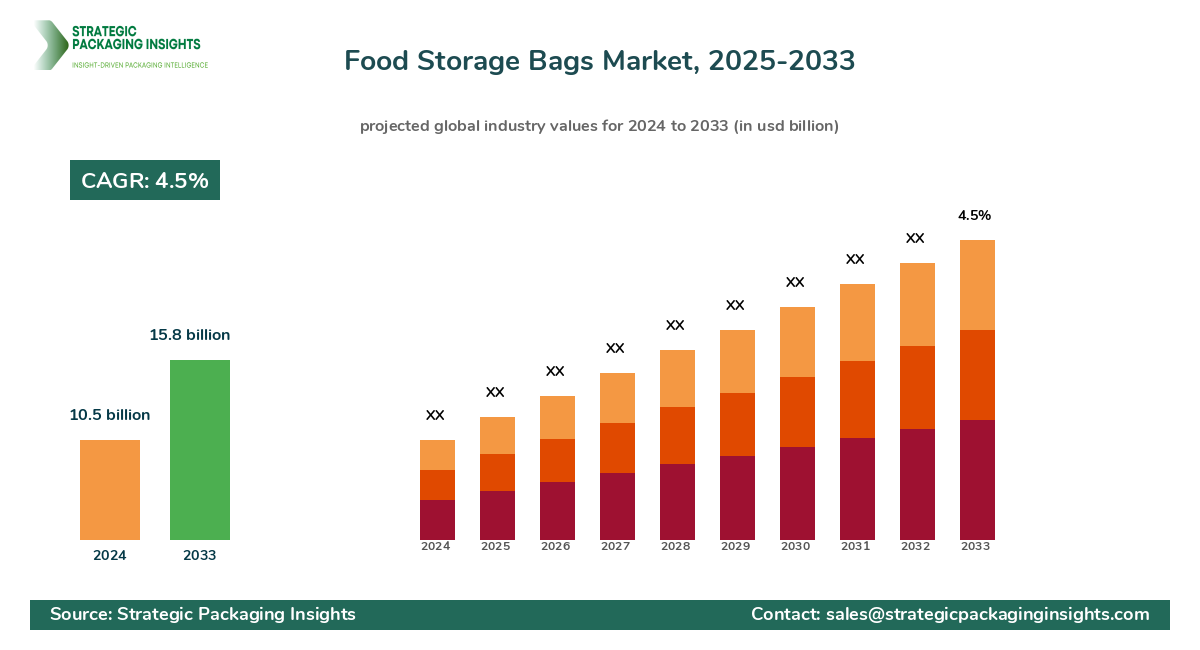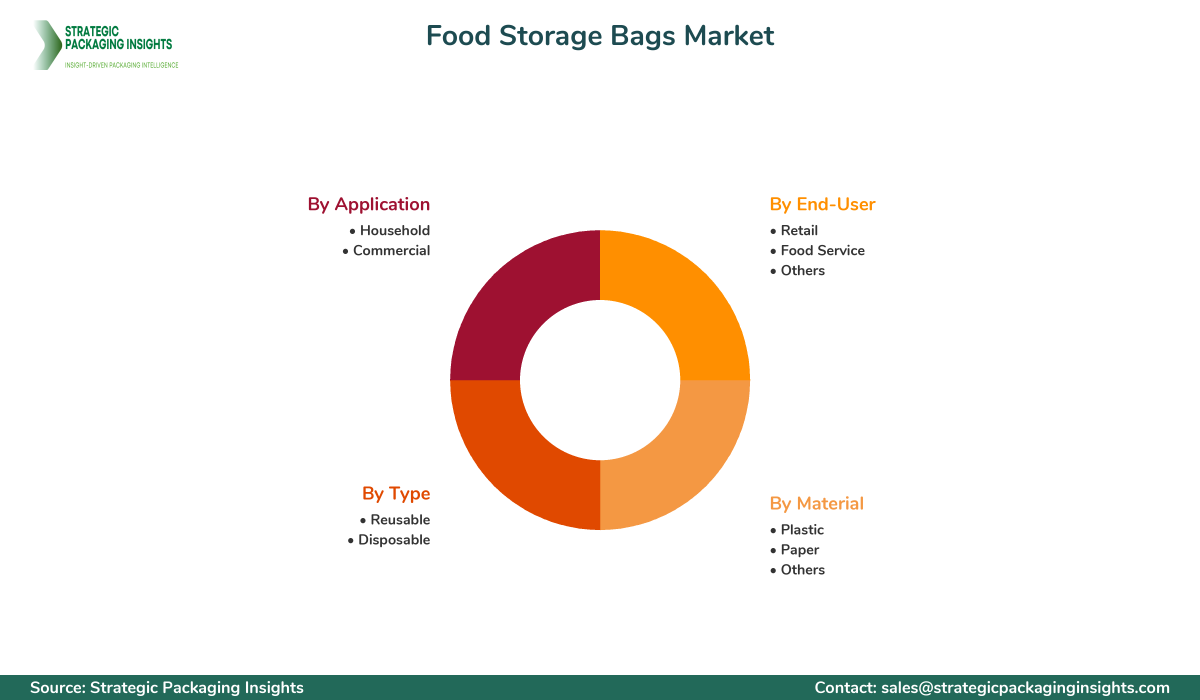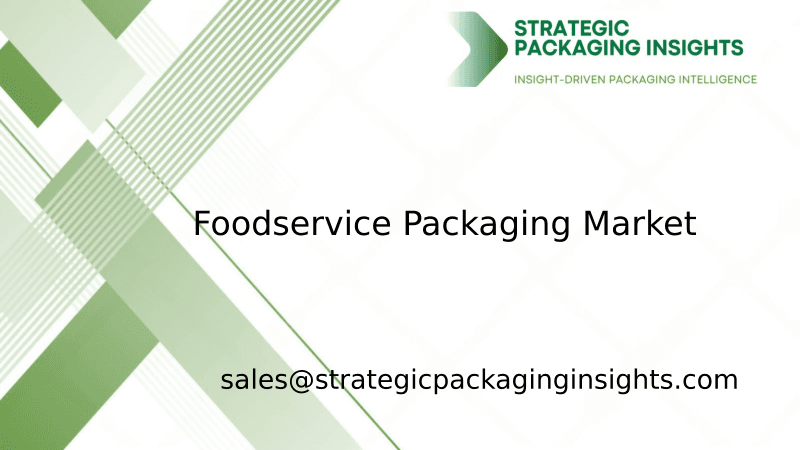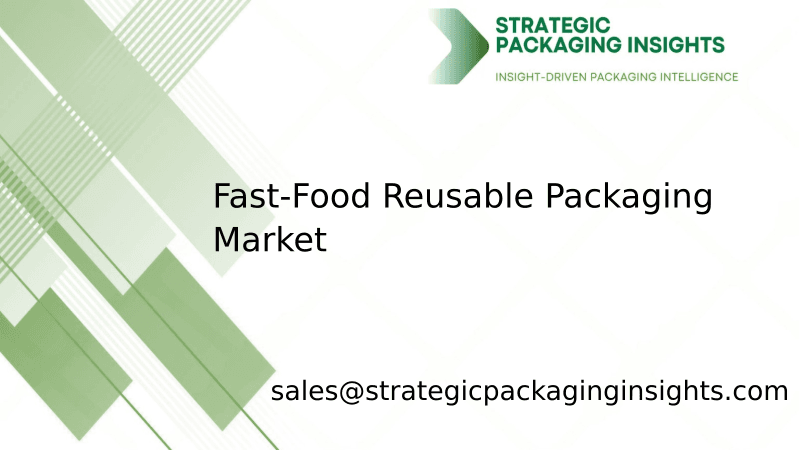- Home
- Food Packaging
- Food Storage Bags Market Size, Future Growth and Forecast 2033
Food Storage Bags Market Size, Future Growth and Forecast 2033
Food Storage Bags Market Segments - by Material (Plastic, Paper, Others), Type (Reusable, Disposable), Application (Household, Commercial), and End-User (Retail, Food Service, Others) - Market Dynamics, Growth Opportunities, Strategic Drivers, and PESTLE Outlook (2025–2033)
Food Storage Bags Market Outlook
The food storage bags market was valued at $10.5 billion in 2024 and is projected to reach $15.8 billion by 2033, growing at a CAGR of 4.5% during the forecast period 2025–2033. This market is driven by the increasing demand for convenient and efficient food storage solutions, particularly in urban areas where space is limited. The rise in consumer awareness regarding food safety and hygiene has further propelled the demand for food storage bags. Additionally, the growing trend of meal prepping and the need for portion control are contributing to the market's expansion. The market is also benefiting from innovations in materials and designs that enhance the functionality and sustainability of food storage bags.
However, the market faces challenges such as stringent environmental regulations and the growing consumer preference for eco-friendly alternatives. The increasing awareness of the environmental impact of plastic waste is pushing manufacturers to develop biodegradable and recyclable options, which can be more costly. Despite these challenges, the market holds significant growth potential due to the rising demand for Sustainable Packaging solutions. Companies are investing in research and development to create innovative products that meet both consumer needs and regulatory requirements, thereby opening new avenues for growth.
Report Scope
| Attributes | Details |
| Report Title | Food Storage Bags Market Size, Future Growth and Forecast 2033 |
| Base Year | 2024 |
| Historic Data | 2017-2023 |
| Forecast Period | 2025-2033 |
| Number of Pages | 186 |
| Material | Plastic, Paper, Others |
| Type | Reusable, Disposable |
| Application | Household, Commercial |
| End-User | Retail, Food Service, Others |
| Customization Available | Yes* |
Opportunities & Threats
The food storage bags market presents numerous opportunities for growth, particularly in the development of eco-friendly and sustainable products. As consumers become more environmentally conscious, there is a growing demand for biodegradable and compostable food storage bags. This shift in consumer preference is encouraging manufacturers to invest in sustainable materials and innovative designs that reduce environmental impact. Additionally, the increasing trend of online grocery shopping is driving the demand for efficient and reliable food storage solutions, creating new opportunities for market expansion.
Another significant opportunity lies in the customization and personalization of food storage bags. With the rise of e-commerce and direct-to-consumer brands, there is a growing demand for unique and Personalized Packaging solutions. Companies can capitalize on this trend by offering customizable food storage bags that cater to specific consumer needs and preferences. This not only enhances brand loyalty but also allows companies to differentiate themselves in a competitive market.
Despite these opportunities, the market faces several threats, including the volatility of raw material prices and the increasing competition from alternative packaging solutions. The rising cost of raw materials, particularly plastics, can impact profit margins and pose a challenge for manufacturers. Additionally, the growing popularity of alternative packaging solutions, such as reusable containers and beeswax wraps, presents a threat to the traditional food storage bags market. Companies must continuously innovate and adapt to changing consumer preferences to remain competitive.
The food storage bags market is characterized by a highly competitive landscape, with numerous players vying for market share. The market is dominated by a few key players who hold a significant share, while several smaller companies compete in niche segments. The competitive landscape is shaped by factors such as product innovation, brand reputation, and distribution networks. Companies are focusing on expanding their product portfolios and enhancing their distribution channels to gain a competitive edge.
Major companies in the market include SC Johnson & Son, Inc., The Clorox Company, and Reynolds Consumer Products LLC, which hold substantial market shares due to their strong brand presence and extensive distribution networks. These companies are investing in research and development to introduce innovative products that cater to evolving consumer needs. For instance, SC Johnson & Son, Inc. has been focusing on developing sustainable and eco-friendly food storage solutions to meet the growing demand for environmentally conscious products.
Other notable players in the market include Berry Global Inc., Inteplast Group, and Novolex Holdings, Inc. These companies are leveraging their expertise in packaging solutions to expand their presence in the food storage bags market. Berry Global Inc., for example, is known for its extensive range of Plastic Packaging Products and is continuously innovating to offer sustainable solutions. Inteplast Group, on the other hand, focuses on providing high-quality and cost-effective packaging solutions to meet diverse consumer needs.
In addition to these major players, several smaller companies are making their mark in the market by offering specialized and niche products. Companies like Stasher Inc. and Bee's Wrap are gaining popularity for their innovative and eco-friendly food storage solutions. Stasher Inc. is known for its reusable silicone bags, while Bee's Wrap offers sustainable alternatives made from beeswax. These companies are capitalizing on the growing demand for sustainable packaging solutions and are expanding their market presence through strategic partnerships and collaborations.
Key Highlights Food Storage Bags Market

- Increasing demand for eco-friendly and sustainable food storage solutions.
- Rising consumer awareness regarding food safety and hygiene.
- Growth in online grocery shopping driving demand for efficient storage solutions.
- Customization and personalization of food storage bags gaining traction.
- Innovations in materials and designs enhancing product functionality.
- Stringent environmental regulations influencing market dynamics.
- Volatility of raw material prices impacting profit margins.
- Growing competition from alternative packaging solutions.
- Expansion of distribution networks by major market players.
- Investment in research and development for product innovation.
Top Countries Insights in Food Storage Bags
The United States is a leading market for food storage bags, with a market size of $3.5 billion and a CAGR of 5%. The country's large consumer base and high demand for convenient food storage solutions drive market growth. Additionally, the increasing trend of meal prepping and the need for portion control contribute to the market's expansion. However, the market faces challenges such as stringent environmental regulations and the growing preference for eco-friendly alternatives.
China is another significant market, with a market size of $2.8 billion and a CAGR of 6%. The country's rapidly growing population and increasing urbanization drive the demand for food storage bags. The rise in disposable income and changing consumer lifestyles further contribute to market growth. However, the market faces challenges such as the volatility of raw material prices and the increasing competition from alternative packaging solutions.
Germany is a key market in Europe, with a market size of $1.2 billion and a CAGR of 4%. The country's strong focus on sustainability and environmental consciousness drives the demand for eco-friendly food storage solutions. Additionally, the increasing trend of online grocery shopping and the need for efficient storage solutions contribute to market growth. However, the market faces challenges such as stringent environmental regulations and the growing competition from alternative packaging solutions.
India is an emerging market, with a market size of $1 billion and a CAGR of 7%. The country's rapidly growing population and increasing urbanization drive the demand for food storage bags. The rise in disposable income and changing consumer lifestyles further contribute to market growth. However, the market faces challenges such as the volatility of raw material prices and the increasing competition from alternative packaging solutions.
Brazil is a growing market, with a market size of $0.8 billion and a CAGR of 5%. The country's large consumer base and high demand for convenient food storage solutions drive market growth. Additionally, the increasing trend of meal prepping and the need for portion control contribute to the market's expansion. However, the market faces challenges such as stringent environmental regulations and the growing preference for eco-friendly alternatives.
Value Chain Profitability Analysis
The food storage bags market value chain involves several key stakeholders, including raw material suppliers, manufacturers, distributors, and retailers. Each stage of the value chain contributes to the overall profitability of the market, with varying profit margins and revenue distribution. Raw material suppliers, primarily those providing plastics and other materials, capture a significant share of the market value due to the high demand for quality materials. Manufacturers, who convert these materials into finished products, also hold a substantial share of the market value, driven by their ability to innovate and produce cost-effective solutions.
Distributors and retailers play a crucial role in the value chain by ensuring the availability of food storage bags to end consumers. These stakeholders capture a moderate share of the market value, with profit margins influenced by factors such as distribution costs and retail pricing strategies. The rise of e-commerce and direct-to-consumer sales channels is reshaping the value chain, allowing manufacturers to capture a larger share of the market value by bypassing traditional distribution networks.
Digital transformation is also impacting the value chain, with technology platforms enabling more efficient production processes and supply chain management. This shift is redistributing revenue opportunities throughout the industry, with manufacturers and retailers leveraging digital tools to enhance their operations and improve profitability. As the market continues to evolve, stakeholders must adapt to changing consumer preferences and technological advancements to maintain their competitive edge.
Evolving Market Dynamics (2018–2024) and Strategic Foresight (2025–2033)
The food storage bags market has undergone significant changes between 2018 and 2024, driven by factors such as increasing consumer awareness of food safety and hygiene, the rise of online grocery shopping, and the growing demand for sustainable packaging solutions. During this period, the market experienced a steady CAGR of 3.5%, with a focus on product innovation and the expansion of distribution networks. The introduction of eco-friendly and biodegradable products gained traction, as companies responded to consumer demand for environmentally conscious solutions.
Looking ahead to 2025–2033, the market is expected to grow at a CAGR of 4.5%, with continued emphasis on sustainability and innovation. The shift towards digital transformation and the rise of e-commerce will play a significant role in shaping market dynamics, as companies leverage technology to enhance their operations and reach a broader consumer base. The increasing trend of customization and personalization of food storage bags will also drive market growth, as consumers seek unique and tailored solutions.
Regional contributions are expected to shift, with emerging markets such as India and Brazil experiencing higher growth rates compared to mature markets like the United States and Germany. Technological advancements, such as the development of smart packaging solutions, will further impact market dynamics, offering new opportunities for growth and differentiation. Companies must remain agile and responsive to these changes, focusing on strategic partnerships and collaborations to stay competitive in a rapidly evolving market.
Food Storage Bags Market Segments Insights

Material Analysis
The material segment of the food storage bags market is dominated by plastic, which accounts for the largest share due to its versatility, durability, and cost-effectiveness. However, the growing environmental concerns and regulatory pressures are driving the demand for alternative materials such as paper and biodegradable options. Companies are investing in research and development to create innovative materials that offer the same functionality as plastic while reducing environmental impact. The shift towards sustainable materials is expected to gain momentum, with consumers increasingly opting for eco-friendly solutions.
Paper-based food storage bags are gaining popularity due to their biodegradability and recyclability. These bags are particularly favored in regions with stringent environmental regulations and high consumer awareness of sustainability issues. The demand for Paper Bags is also driven by the increasing trend of organic and natural food products, which often require packaging that aligns with their eco-friendly image. As the market continues to evolve, the material segment is expected to witness significant changes, with a growing emphasis on sustainability and innovation.
Type Analysis
The type segment of the food storage bags market is divided into reusable and disposable bags. Reusable bags are gaining traction due to their environmental benefits and cost savings over time. These bags are typically made from durable materials such as silicone or fabric, which can withstand multiple uses and are easy to clean. The growing consumer awareness of sustainability and the desire to reduce single-use plastic waste are driving the demand for reusable food storage bags. Companies are responding to this trend by offering a wide range of reusable options in various sizes and designs to cater to diverse consumer needs.
Disposable food storage bags, on the other hand, continue to hold a significant share of the market due to their convenience and affordability. These bags are commonly used for short-term storage and are popular among consumers who prioritize convenience over sustainability. However, the increasing environmental concerns and regulatory pressures are prompting manufacturers to develop biodegradable and compostable disposable bags. The type segment is expected to witness a shift towards reusable options, driven by changing consumer preferences and regulatory requirements.
Application Analysis
The application segment of the food storage bags market is primarily divided into household and commercial use. Household applications account for the largest share of the market, driven by the increasing demand for convenient and efficient food storage solutions. The rise of meal prepping and the need for portion control are contributing to the growth of this segment. Consumers are increasingly seeking products that offer ease of use, durability, and the ability to preserve food freshness, driving the demand for innovative food storage bags.
Commercial applications, including the food service and retail sectors, are also experiencing significant growth. The increasing trend of online grocery shopping and the need for efficient packaging solutions are driving the demand for food storage bags in the commercial sector. Companies are focusing on developing products that cater to the specific needs of commercial users, such as larger sizes and enhanced durability. The application segment is expected to witness continued growth, driven by the increasing demand for convenient and reliable food storage solutions across both household and commercial sectors.
End-User Analysis
The end-user segment of the food storage bags market includes retail, food service, and other sectors. The retail sector accounts for the largest share of the market, driven by the increasing demand for packaged food products and the rise of online grocery shopping. Retailers are focusing on offering a wide range of food storage solutions to cater to diverse consumer needs, driving the demand for innovative and sustainable products. The growing trend of customization and personalization in packaging is also contributing to the growth of this segment.
The food service sector is experiencing significant growth, driven by the increasing demand for convenient and efficient packaging solutions. The rise of food delivery services and the need for reliable packaging that preserves food quality and freshness are contributing to the growth of this segment. Companies are focusing on developing products that cater to the specific needs of the food service sector, such as leak-proof and temperature-resistant bags. The end-user segment is expected to witness continued growth, driven by the increasing demand for innovative and reliable food storage solutions across various sectors.
Food Storage Bags Market Segments
The Food Storage Bags market has been segmented on the basis of
Material
- Plastic
- Paper
- Others
Type
- Reusable
- Disposable
Application
- Household
- Commercial
End-User
- Retail
- Food Service
- Others
Primary Interview Insights
What are the key drivers of growth in the food storage bags market?
How are companies responding to the demand for eco-friendly products?
What challenges does the market face?
How is digital transformation impacting the market?
What are the emerging trends in the food storage bags market?
Latest Reports

The corrugated board packaging market was valued at $250 billion in 2024 and is projected to reach $380 billion by 2033, growing at a CAGR of 4.5% during the forecast period 2025–2033.

The Water Soluble Packaging Films market was valued at $2.8 billion in 2024 and is projected to reach $5.6 billion by 2033, growing at a CAGR of 8.1% during the forecast period 2025–2033.

The Aluminium Foil Packaging market was valued at $25 billion in 2024 and is projected to reach $40 billion by 2033, growing at a CAGR of 5.5% during the forecast period 2025–2033.

The self-heating food packaging market was valued at $4.5 billion in 2024 and is projected to reach $7.8 billion by 2033, growing at a CAGR of 6.2% during the forecast period 2025–2033.

The Smart Container market was valued at $2.5 billion in 2024 and is projected to reach $8.7 billion by 2033, growing at a CAGR of 14.5% during the forecast period 2025–2033.

The Automatic Labeling Machine market was valued at $2.5 billion in 2024 and is projected to reach $4.8 billion by 2033, growing at a CAGR of 7.2% during the forecast period 2025–2033.

The Hot Melt Glue Labeler market was valued at $1.2 billion in 2024 and is projected to reach $2.3 billion by 2033, growing at a CAGR of 6.5% during the forecast period 2025–2033.

The Ethical Label market was valued at $1.5 billion in 2024 and is projected to reach $3.2 billion by 2033, growing at a CAGR of 8.5% during the forecast period 2025–2033.

The Packaging Tensioner market was valued at $1.2 billion in 2024 and is projected to reach $2.3 billion by 2033, growing at a CAGR of 6.5% during the forecast period 2025–2033.

The foodservice packaging market was valued at $120 billion in 2024 and is projected to reach $180 billion by 2033, growing at a CAGR of 4.5% during the forecast period 2025–2033.

The nano-enabled packaging market was valued at $15.2 billion in 2024 and is projected to reach $35.6 billion by 2033, growing at a CAGR of 9.5% during the forecast period 2025–2033.

The Cold Seal Packaging market was valued at $1.5 billion in 2024 and is projected to reach $2.3 billion by 2033, growing at a CAGR of 4.8% during the forecast period 2025–2033.

The Transparent Barrier Packaging Films market was valued at $12.5 billion in 2024 and is projected to reach $20.3 billion by 2033, growing at a CAGR of 5.8% during the forecast period 2025–2033.

The Flatback Tape market was valued at $2.5 billion in 2024 and is projected to reach $4.1 billion by 2033, growing at a CAGR of 5.8% during the forecast period 2025–2033.

The packer bottle market was valued at $3.5 billion in 2024 and is projected to reach $5.8 billion by 2033, growing at a CAGR of 5.2% during the forecast period 2025–2033.

The Canada Nano-Enabled Packaging Food Beverages market was valued at $1.2 billion in 2024 and is projected to reach $3.5 billion by 2033, growing at a CAGR of 12.5% during the forecast period 2025–2033.

The India Aluminum Beverage Can market was valued at $1.2 billion in 2024 and is projected to reach $2.5 billion by 2033, growing at a CAGR of 8.5% during the forecast period 2025–2033.

The fast-food reusable packaging market was valued at $1.2 billion in 2024 and is projected to reach $3.5 billion by 2033, growing at a CAGR of 12.5% during the forecast period 2025–2033.

The pallets market was valued at $59.91 billion in 2024 and is projected to reach $88.69 billion by 2033, growing at a CAGR of 4.5% during the forecast period 2025–2033.

The lamination adhesives market was valued at $2.5 billion in 2024 and is projected to reach $4.1 billion by 2033, growing at a CAGR of 5.8% during the forecast period 2025–2033.

The garment packing machine market was valued at $1.2 billion in 2024 and is projected to reach $2.5 billion by 2033, growing at a CAGR of 8.5% during the forecast period 2025–2033.

The shrink bags market was valued at $3.5 billion in 2024 and is projected to reach $5.8 billion by 2033, growing at a CAGR of 5.2% during the forecast period 2025–2033.

The beverage packaging market was valued at $128 billion in 2024 and is projected to reach $186 billion by 2033, growing at a CAGR of 4.2% during the forecast period 2025–2033.

The North America Freight and Logistics market was valued at $1,200 billion in 2024 and is projected to reach $1,800 billion by 2033, growing at a CAGR of 4.5% during the forecast period 2025–2033.

The Anti-Counterfeiting Packaging market was valued at $105 billion in 2024 and is projected to reach $182 billion by 2033, growing at a CAGR of 6.5% during the forecast period 2025–2033.

The corrugated board packaging market was valued at $250 billion in 2024 and is projected to reach $380 billion by 2033, growing at a CAGR of 4.5% during the forecast period 2025–2033.

The Water Soluble Packaging Films market was valued at $2.8 billion in 2024 and is projected to reach $5.6 billion by 2033, growing at a CAGR of 8.1% during the forecast period 2025–2033.

The Aluminium Foil Packaging market was valued at $25 billion in 2024 and is projected to reach $40 billion by 2033, growing at a CAGR of 5.5% during the forecast period 2025–2033.

The self-heating food packaging market was valued at $4.5 billion in 2024 and is projected to reach $7.8 billion by 2033, growing at a CAGR of 6.2% during the forecast period 2025–2033.

The Smart Container market was valued at $2.5 billion in 2024 and is projected to reach $8.7 billion by 2033, growing at a CAGR of 14.5% during the forecast period 2025–2033.

The Automatic Labeling Machine market was valued at $2.5 billion in 2024 and is projected to reach $4.8 billion by 2033, growing at a CAGR of 7.2% during the forecast period 2025–2033.

The Hot Melt Glue Labeler market was valued at $1.2 billion in 2024 and is projected to reach $2.3 billion by 2033, growing at a CAGR of 6.5% during the forecast period 2025–2033.

The Ethical Label market was valued at $1.5 billion in 2024 and is projected to reach $3.2 billion by 2033, growing at a CAGR of 8.5% during the forecast period 2025–2033.

The Packaging Tensioner market was valued at $1.2 billion in 2024 and is projected to reach $2.3 billion by 2033, growing at a CAGR of 6.5% during the forecast period 2025–2033.

The foodservice packaging market was valued at $120 billion in 2024 and is projected to reach $180 billion by 2033, growing at a CAGR of 4.5% during the forecast period 2025–2033.

The nano-enabled packaging market was valued at $15.2 billion in 2024 and is projected to reach $35.6 billion by 2033, growing at a CAGR of 9.5% during the forecast period 2025–2033.

The Cold Seal Packaging market was valued at $1.5 billion in 2024 and is projected to reach $2.3 billion by 2033, growing at a CAGR of 4.8% during the forecast period 2025–2033.

The Transparent Barrier Packaging Films market was valued at $12.5 billion in 2024 and is projected to reach $20.3 billion by 2033, growing at a CAGR of 5.8% during the forecast period 2025–2033.

The Flatback Tape market was valued at $2.5 billion in 2024 and is projected to reach $4.1 billion by 2033, growing at a CAGR of 5.8% during the forecast period 2025–2033.

The packer bottle market was valued at $3.5 billion in 2024 and is projected to reach $5.8 billion by 2033, growing at a CAGR of 5.2% during the forecast period 2025–2033.

The Canada Nano-Enabled Packaging Food Beverages market was valued at $1.2 billion in 2024 and is projected to reach $3.5 billion by 2033, growing at a CAGR of 12.5% during the forecast period 2025–2033.

The India Aluminum Beverage Can market was valued at $1.2 billion in 2024 and is projected to reach $2.5 billion by 2033, growing at a CAGR of 8.5% during the forecast period 2025–2033.

The fast-food reusable packaging market was valued at $1.2 billion in 2024 and is projected to reach $3.5 billion by 2033, growing at a CAGR of 12.5% during the forecast period 2025–2033.

The pallets market was valued at $59.91 billion in 2024 and is projected to reach $88.69 billion by 2033, growing at a CAGR of 4.5% during the forecast period 2025–2033.

The lamination adhesives market was valued at $2.5 billion in 2024 and is projected to reach $4.1 billion by 2033, growing at a CAGR of 5.8% during the forecast period 2025–2033.

The garment packing machine market was valued at $1.2 billion in 2024 and is projected to reach $2.5 billion by 2033, growing at a CAGR of 8.5% during the forecast period 2025–2033.

The shrink bags market was valued at $3.5 billion in 2024 and is projected to reach $5.8 billion by 2033, growing at a CAGR of 5.2% during the forecast period 2025–2033.

The beverage packaging market was valued at $128 billion in 2024 and is projected to reach $186 billion by 2033, growing at a CAGR of 4.2% during the forecast period 2025–2033.

The North America Freight and Logistics market was valued at $1,200 billion in 2024 and is projected to reach $1,800 billion by 2033, growing at a CAGR of 4.5% during the forecast period 2025–2033.

The Anti-Counterfeiting Packaging market was valued at $105 billion in 2024 and is projected to reach $182 billion by 2033, growing at a CAGR of 6.5% during the forecast period 2025–2033.
